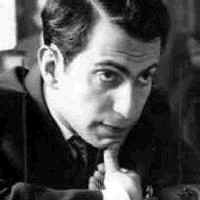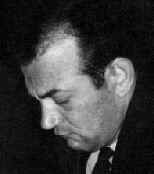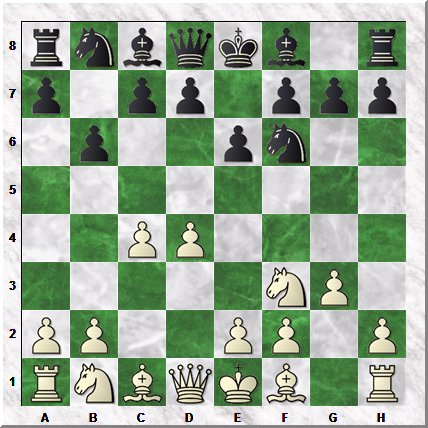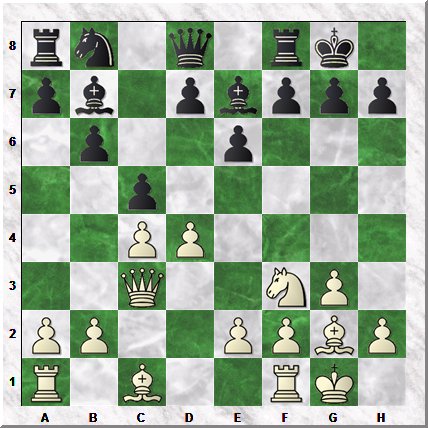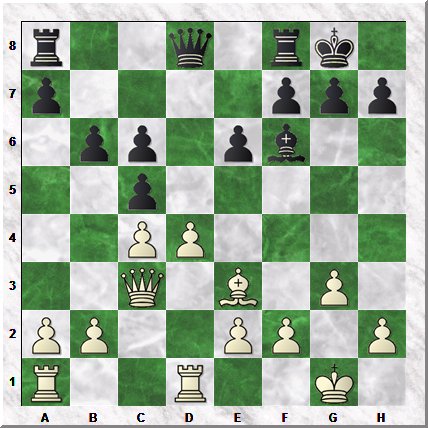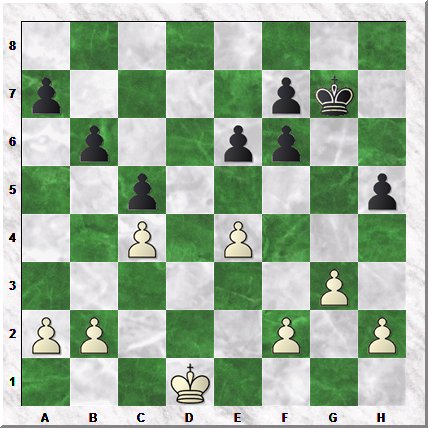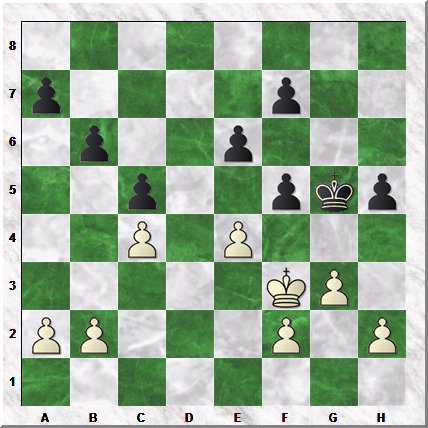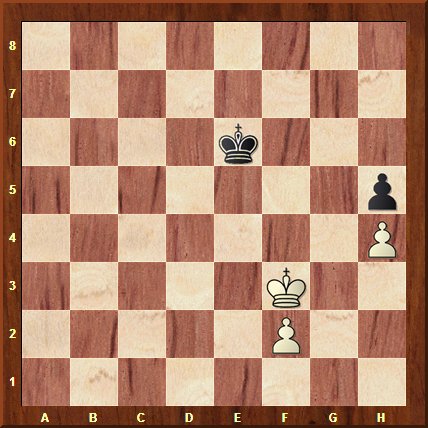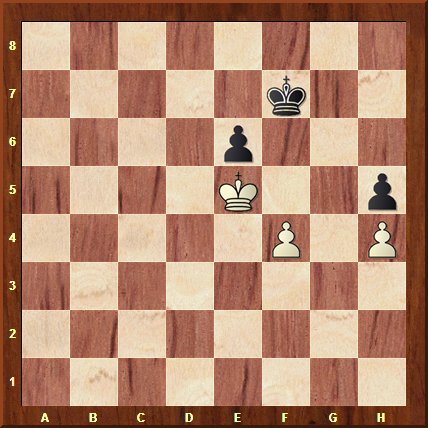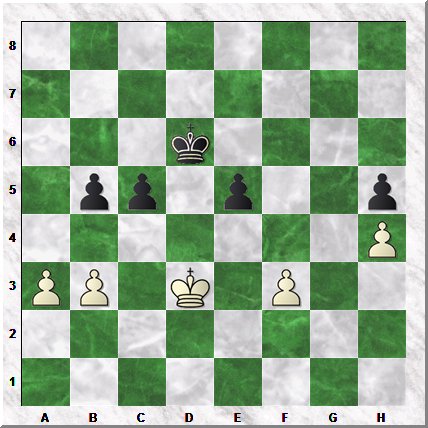All
the |
(Navigation bar
directly below.)
*******
© A.J. Goldsby, 2015.
(All rights reserved.)
****************
Click HERE
to see my
Chess Items.
****************
****************
Buy a book
from Amazon.com
(And help me out as well!)
****************
Click HERE
...
to see a list of the businesses that help to sponsor all of
my chess efforts.
|
|
|
This is an extremely famous chess game, a great deal has been written about it over the years. According to the critics/pundits, Tal missed a win in a pure K+P ending. However, I have had a great deal of experience with this game over the years. A few of them are:
As a result of all of this, I went back and checked everything with a fine-tooth comb. I used multiple engines, Deep Fritz 14, Houdini 3.0, Stockfish, Deep Shredder, etc. (All the better engines told the same story: for almost the entire game, neither side ever gained an appreciable advantage, a the end of the game, all the engines show an evaluation of "0.00," meaning that it is a dead draw.) I decided to make a web page out of my analysis and invite any and all players, (it does not matter if they hold a FIDE title or not); to take a look ... we will let public opinion decide whether or not I am correct. Just one other quick note here ... which is sort of a pre-emptive strike. Korchnoi's style has always been to "tread on the line," and play dangerous ... and often even provocative moves. I fully understand his style, and I must have at least 5-7 books on Korchnoi or about Korchnoi. Of course, during the course of the game, I simply want to comment on the moves themselves, and not go into questions of chess style. I must also comment that Tal had a reputation for possibly unsound combinations, however (in this game) his play was of the highest level and he played nearly perfect chess ... many of his moves are the first or second choice of the chess engines. |
|
Click HERE to see an explanation of the symbols that I commonly use when I annotate any chess game. Click HERE to replay this game. (Click HERE to see a "star-dot-pdf" / Adobe copy of my analysis.) Click HERE to see my video channel on the "You-Tube" channel. (Click HERE to see my YT video on this game.) |
|
GM Mikhail
Tal (My page on him.) |
GM V.
Korchnoi His FIDE card. |
|
Mihail Tal
(2757) - Viktor Kortschnoj
(2759) [A.J. Goldsby I] This is a very famous draw ... my main focus here was obviously the K+P endgame. I saw it analyzed in several
books ... and also a great number of magazines over the years. ******************************************************************************************** [
The ratings come from the historical ratings website, "Chess Metrics," by the
respected statistician, Jeff
Sonas. 1.d4 Nf6; 2.c4 e6; 3.Nf3 b6; 4.g3, (fianchetto) This is a solid play but it
is also the older move.
rnbqkb1r/p1pp1ppp/1p2pn2/8/2PP4/5NP1/PP2PP1P/RNBQKB1R b KQkq - 0 4
[ For more on this opening, see MCO-15, beginning on page # 563. ]
[
I prefer the try: 4.a3, see any good reference work.
4...Bb7; 5.Bg2 Be7; 6.0-0 0-0; 7.Nc3 Ne4!; A known antidote, after this well-timed play by the second party, White has problems trying to really demonstrate a clear edge.
8.Qc2 Nxc3; 9.Qxc3 c5; ('!?') So far, this is all a <<standard>>
book line ... ... ...
rn1q1rk1/pb1pbppp/1p2p3/2p5/2PP4/2Q2NP1/PP2PPBP/R1B2RK1 w - c6 0 10
This move, (9...c7-c5!?) is
probably sufficient for equality, any exchange in the center will lessen
White's dominance there. A fairly good and relatively
recent example of this game would have to be:
10.Be3 Bf6; 11.Rfd1!? Bxf3!; 12.Bxf3 Nc6; 13.Bxc6 dxc6; Temporarily, Black has doubled Pawns, but they are about to be liquidated ...
r2q1rk1/p4ppp/1pp1pb2/2p5/2PP4/2Q1B1P1/PP2PP1P/R2R2K1 w - - 0 14
The current position makes for an interesting diagram. {See just above.}
White now penetrates to the 7th rank, the result of which is just more exchanges. 14.Qd3 cxd4; 15.Bxd4 c5; 16.Bc3 Qe7; 17.Qd7 Rfd8; 18.Qxe7 Bxe7; 19.e4 h5!?; This is not a bad move but Houdini's plan of >/= 19...f6; and then 20...Kf7; has to be a little better.
20.Kf1 Bf6!?; (Too risky?) Korchnoi gives himself doubled Pawns on the King-side. While not losing, I think it was unnecessary ... the plan outlined after the previous ply-set has to be less risky. (Editor's note ... the Informant awards this move a full question mark. However, as this move only causes a tiny disturbance in the engine's overall evaluation, this is obviously much too harsh a judgment!)
21.Bxf6 gxf6; 22.Ke2 Kg7; 23.Rxd8, (paring-down) M. Tal, a great master of the endgame, knows that the doubled Pawns in Black's camp means that White will have some real winning chances.
[ RR 23.a3 Kg6; "~" (unclear) ]
23...Rxd8; 24.Rd1 Rxd1; 25.Kxd1, ("=")
A king-and-pawn-endgame has been reached, most engines show that the current position is very close to dead level.
8/p4pk1/1p2pp2/2p4p/2P1P3/6P1/PP3P1P/3K4 b - - 0 25
If White has any advantage at all, then engines like Houdini 3.0, DF14 and also Deep Shredder ...
I spent almost a full day analyzing this K+P endgame ... with the help of several strong chess engines.
25...Kg6!; 26.Ke2 Kg5!?;
There is probably nothing seriously wrong with this move, but here it just doesn't feel right.
To be fair, however, I should point out that 26...Kg5; IS the top choice of several good chess engines - like Stockfish.
[ Deep Fritz 14 gives the following line here: (>/=)
27.Kf3 f5!?; (hmmm) Probably ... eventually ... Black has to play this, but it is all a question of timing.
8/p4p2/1p2p3/2p2pkp/2P1P3/5KP1/PP3P1P/8 w - - 0 28
We have reached the critical position, and it is definitely time for another diagram.
In this position, Smyslov once published an analysis in one chess magazine ... which ran several pages. In that work, both Smyslov and Furman strongly asserted that 28.e5! would have won the game for White.
[ RR 27...a6; 28.h4+, "+/=" ]
28.h3!?, (Ha, ha, ha!)
The play of h2-h3 ... originally given a question mark by Smyslov and Furman and then the same judgment was agreed upon by Paul Keres ... The
section (just below)
is my detailed examination of the main line of this very complex K+P
endgame ...
[ For a very long time, I follow the analysis of Smyslov and Furman, quoted in the book,
RR
28.e5! f6!; 29.h4+! Kg6;
30.Kf4 a6!; 31.a3! b5!!;
32.cxb5 axb5; 33.b3! fxe5+;
34.Ke3!!, (Amazing!)
(
The following line - found mostly by the chess engines -
(All White had to do to draw this ending was to find the following line:
37...bxa4!;
38.bxa4 Ke7;
39.a5 Kd7; 40.a6 Kc6;
41.a7 Kb7; (zugzwang) 42.Kxe6 c4; "-/+" Black is winning easily. )
Now a careless move ... like playing the Black King to the h6-square ... will lose to a4! 34...f4+!; (Correct!) Black returns the material, other lines are not convincing. (See the analysis, just below.) *** *** *** *** *** *** *** *** *** *** *** *** *** *** *** *** *** *** *** *** *** *** *** ***
(
Yuri Averbakh and I Maizelis, in the book: "Pawn
Endings,"
</= 34...Kf6?;
(bad)
35.a4 bxa4;
36.bxa4 Ke7;
37.Kd3 Kd6; 38.Kc4 Kc6;
39.a5 f4;
8/8/4k3/7p/7P/5K2/5P2/8 b - - 0 48 White is winning ... you can check this position with any engine you like. ) *** *** *** *** *** *** *** *** *** *** *** *** *** *** *** *** *** *** *** *** *** *** *** ***
Going back to the our original line of analysis,
(White has to capture, 35.Kd2?!, fxg3;
'/+' will favor
Black.): *** *** *** *** *** *** *** *** *** *** *** *** *** *** *** *** *** *** *** *** *** *** *** ***
( Our famous crew of analysts only give the following
(grossly inferior) line: 42.Kxb3 e5; 43.f3!, "+/-" when White wins easily.
(In case you are not yet convinced that Black is completely lost ...
43.f3 b4!?;
(human)
(Just blindly following the engine moves yields the following variation here: 44.a6 Kb6; 45.Kxb4 Kxa6; 46.Kc5 Kb7; 47.Kd5, +-) ) *** *** *** *** *** *** *** *** *** *** *** *** *** *** *** *** *** *** *** *** *** *** *** *** (We return to the main stem of our analysis line here.)
42.Kxb3 Kc5; 43.Kc3 b4+;
44.Kb3 Kb5; 45.a6 Kxa6;
46.Kxb4 Kb6; (stand-off)
47.Kc4 Kc6; 48.Kd4 Kd6;
49.Ke4 Ke7; 50.Ke5, (opposition)
( Or White could try: RR
50.Kf4 Kf6; 51.f3 e5+; 52.Ke4 Ke6;
"="
50...Kf7; 51.f3 Ke7; 52.f4 Kf7;
"=" (100% equal!)
8/5k2/4p3/4K2p/5P1P/8/8/8 w - - 0 53
This analysis diagram should convince even the most hardened skeptic. After a deep analysis of some of the potential K+P endings, we return to the actual game. 28...Kf6; 29.Kf4 e5+; 30.Ke3 a6; 31.b3, This is actually the first choice of DF14, but Smyslov, Furman and Keres seem to think it was clearly inferior!
[ In the book, "Power
Chess," Keres claims that the following This is OK but Houdini shows that 31...b5! (right away) might be even better.
32.exf5+ Kxf5; 33.f3
f6; 34.g4+!?, (Premature?)
(Probably a little more tricky was the following line here:
34...hxg4; 35.hxg4+ Ke6!;
36.Ke4 b5!; 37.cxb5 axb5;
38.b3 Kd6; 39.Kd3 Kc6!;
"=" *** *** *** *** *** *** *** *** *** *** *** *** *** *** *** *** *** *** *** ***
The continuation of: 31.exf5 Kxf5;
32.f3 Ke6;
33.g4 f5; 34.g5,
"+/=" 34...Kf7;
The rest of the game is pretty much a draw, I saw no "blips" in the engine evals ... which would indicate that one side (or the other) missed an easy win or made a significant mistake in this endgame.
31...Ke6 ; 32.exf5+ Kxf5;
33.f3 Ke6 ; 34.g4 f5; 35.gxf5+ Kxf5;
8/8/3k4/1pp1p2p/7P/PP1K1P2/8/8 w - - 0 41
Its now a draw ... (Engines at "0.00" again.) A wonderful endgame ... but it seems only one that a chess engine could really fathom.
Copyright (c) A.J. Goldsby, 2014. All rights reserved.
˝ - ˝ BIBLIOGRAPHY:
Further Study / and More Resources
Below is a copy of an email that I received, and as it pertains to this
web page, I did not think Pal would mind if I posted it.
|
The
analysis for this page was prepared with the excellent program,
ChessBase
10.0.
(I
now have ChessBase 11.0; I also used MANY different chess engines ... during the
course of my analysis!)
---> My main engines - for this game - were Deep Fritz 14,
Houdini 3.0, Rybka 4, Fritz 13 and Deep Shredder.
The HTML was polished with several different tools and programs, (mostly FP) ... the text was checked for spelling with MS Word.
If you enjoyed this web-page, please e-mail me any comments!
|
Go ... or return ... to my Home Page for this site. Go (or return) ... to my "Annotated Games" (II) Page. Go
... or return ... to my "Best
Games" Page. ******* Copyright
(c) LM A.J.
Goldsby I ******* This
page was first generated in: September,
2014. |

